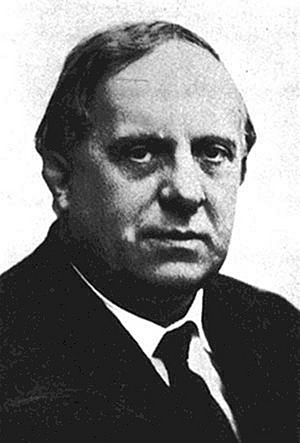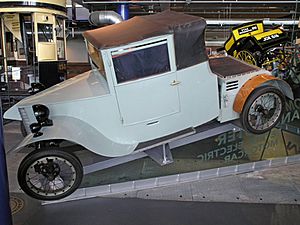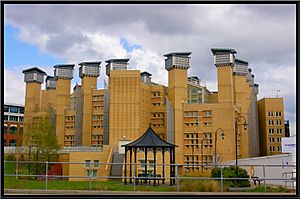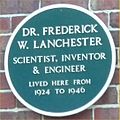Frederick W. Lanchester facts for kids
Quick facts for kids
Frederick W. Lanchester
|
|
|---|---|
 |
|
| Born | 23 October 1868 18 Alma Square, St John's Wood, London
|
| Died | 8 March 1946 (aged 77) |
| Nationality | English |
| Occupation | Engineer |
| Parent(s) | Henry Jones Lanchester |
| Relatives |
|
| Engineering career | |
| Significant advance | |
| Awards |
|

Frederick William Lanchester (born October 23, 1868 – died March 8, 1946) was an amazing English engineer and inventor. He was a true polymath, meaning he was an expert in many different fields.
Lanchester made huge contributions to how cars are built (called automotive engineering). He also helped us understand how things fly (called aerodynamics). Plus, he was one of the people who helped create a field called operations research, which is about solving complex problems. He's often seen as one of the top three English car engineers.
Contents
Who Was Frederick Lanchester?
Frederick Lanchester was born in St John's Wood, London. His father, Henry Jones Lanchester, was an architect, and his mother, Octavia, taught Latin and math. Frederick was one of eight children. His brothers, George Herbert and Frank, later joined him in his car company. His sister, Edith Lanchester, was known for fighting for women's rights.
When Frederick was a baby, his family moved to Brighton. He went to school there but didn't stand out much. He later said he felt like nature was "saving his energy" for later. However, he did win scholarships to the Hartley Institution and then to Kensington College (now part of Imperial College). He also took evening classes to learn more about engineering. Even though he didn't get a formal degree, he learned a lot!
In 1888, after finishing his studies, he got a job as a draughtsman (someone who draws technical plans) at the Patent Office. Around this time, he invented and patented a special drawing tool called an "isometrograph."
In 1919, when he was 51, Lanchester married Dorothea Cooper. They didn't have any children. They first lived in London, but in 1924, Lanchester designed and built his own house in Moseley, Birmingham, where they lived for the rest of their lives.
Frederick Lanchester was recognized for his brilliant work. He became a member of the Royal Society in 1922. In 1926, the Royal Aeronautical Society gave him a special fellowship and a gold medal for his work in flight.
In 1925, he started a company called Lanchester Laboratories Ltd. He wanted to do research and develop new things. He even created an improved radio and gramophone speaker. But sadly, he couldn't sell it well because of the Great Depression, a time when many people lost their jobs and money. He worked very hard until his health failed in 1934, and his company had to close. He was later diagnosed with Parkinson's disease. He was very sad that his health problems kept him from helping out during World War II.
He received more awards later in his life, including gold medals from engineering institutions in 1941 and 1945.
Frederick Lanchester was not just an engineer; he had many interests. He had a great singing voice and even published two books of poetry under the name Paul Netherton-Herries.
Even though he was a genius, Lanchester wasn't very good at making money from his inventions. He struggled financially later in life and needed help to stay in his home. He passed away at his home on March 8, 1946.
Lanchester's Amazing Inventions
Early Engines
In 1888, Lanchester started working for the Forward Gas Engine Company in Saltley, Birmingham. He was very smart and made sure that any improvements he invented would belong to him, not the company. This was a good idea!
- Controlling Engine Speed: In 1889, he invented a "Pendulum Governor" to control how fast engines ran. He earned money for every one used.
- Measuring Movement: In 1890, he patented a "Pendulum Accelerometer" to record how fast vehicles sped up or slowed down.
He was promoted to works manager and designed a new, powerful gas engine. It was very efficient. He also invented a way for gas engines to start themselves, selling the rights to another company for a good sum.
Lanchester even rented a small workshop next to the company to do his own experiments. There, he built a small gas engine that powered the company's office and part of the factory.
Petrol Engines and the First Motorboat
Lanchester found it hard to balance his job and his own research. So, in 1893, he left his job to focus on his inventions. He designed a new engine that ran on benzene (a type of fuel).
- Revolutionary Carburettor: A key part of his new engine was a special device called a carburettor. It mixed fuel and air perfectly. His "wick carburettor" was patented in 1905.
Lanchester put his new petrol engine into a flat-bottomed boat. He built the boat in his own garden! In 1904, this boat was launched in Oxford and became the first motorboat built in Britain.
Building Cars
After putting an engine in a boat, the next step was to put it in a car! Lanchester started designing a four-wheeled car.
- First Car Design: He designed a new 5-horsepower engine with two crankshafts that spun in opposite directions. This made the engine run very smoothly. It also had a special epicyclic gearbox (like an automatic transmission) and drove the rear wheels with chains. The car had a wooden body and could seat three people side-by-side.
His first car was finished in 1895 and tested in 1896. It wasn't perfect; it wasn't powerful enough and had problems with the transmission. So, Lanchester went back to the drawing board.
- Improved Car: He designed a new 8-horsepower engine with two cylinders. He also redesigned the gearbox and combined it with the engine. This new engine and transmission were put into the original 1895 car.
Lanchester moved his workshop and even sold his house to pay for his research. He then built a second car with the same improved engine and transmission. This car also had his own special cantilever suspension system. It was finished in 1898 and won a Gold Medal for its design and performance! It became known as the "Gold Medal Phaeton."
In 1898, he made a water-cooled version of his 8-horsepower engine for a boat. In 1900, the Gold Medal Phaeton successfully completed a 1,000-mile car trial.
The Lanchester Engine Company
In 1899, Frederick and his brothers started the Lanchester Engine Company to build cars for sale. They bought a factory in Birmingham.
- New Innovations: Lanchester designed a new 10-horsepower engine. He also invented a special machine to cut worm drive gears for the car's transmission. This machine was used for 25 years! He also introduced splined shafts (parts with grooves) instead of old-fashioned keys, which was another patent. He even designed machines to make roller bearings for the car's axle.
His cars were unique. The engine was placed between the two front seats, not at the front. Instead of a steering wheel, it had a side-mounted tiller (like a boat). The transmission also had a system similar to modern disc brakes. Lanchester was awarded a patent for the disc brake in 1902!
The new 10-horsepower car came out in 1901 and was made until 1905. He even sent experimental models to his friend, the famous writer Rudyard Kipling, to test.
- More Powerful Engines: In 1905, he made a 20-horsepower four-cylinder engine. In 1906, he created a 28-horsepower six-cylinder engine.
- Solving Engine Vibrations: Lanchester scientifically studied why six-cylinder engines vibrated. He invented the torsional crankshaft vibration damper in 1907 to solve this problem. He also invented a harmonic balancer for four-cylinder engines.
The Lanchester Engine Company sold about 350 cars. However, due to problems with the company's directors, it went out of business in 1904. But it was immediately restarted as The Lanchester Motor Company.
During this time, Lanchester also experimented with fuel injection and turbochargers. He added steering wheels to his cars in 1907 and invented the accelerator pedal! He was also one of the first to use detachable wire wheels, pressure-fed oil bearings, and hollow connecting rods.
Eventually, Lanchester became unhappy with the company's directors. In 1910, he resigned as general manager but stayed on as a part-time consultant. His brothers, George and Frank, took over running the company.
Working with Daimler
In 1909, Lanchester became a consultant for the Daimler Company. He worked on many projects, including engines for buses and early British tanks.
- Daimler-Knight Engines: He helped develop the Daimler-Knight engine, which used a special "sleeve-valve" design.
- KPL Bus: He was involved in a hybrid petrol-electric bus project called the KPL bus.
- Daimler-Renard Road Train: He helped improve the engine for the Daimler-Renard Road Train, a type of tractor unit.
- Tractors and Tanks: Lanchester designed a new cylinder head for sleeve-valve engines in 1913. This powerful 105-horsepower Daimler-Knight engine was used in large agricultural tractors and, importantly, in the first British Mark I-IV tanks during World War I.
Lanchester's contract with Daimler ended after the Wall Street Crash of 1929. The Lanchester Motor Company also faced financial trouble. In 1931, the BSA group, which owned Daimler, bought the Lanchester company. From then on, Lanchester cars were built at the Daimler factory.
Understanding Flight
Lanchester started studying how things fly in 1892, long before the first successful powered flight. While traveling across the Atlantic Ocean, he watched herring gulls fly. He noticed how they used their wings to catch air currents without flapping.
- Circulation Theory of Flight: From his observations, Lanchester developed his "circulation theory of flight." This theory explains how wings create lift and drag. It became the basic idea behind modern aerofoil theory, which is how airplane wings are designed.
- Early Rejection: In 1897, he tried to present his ideas to the Physical Society, but they rejected it because it was too advanced for its time. He realized that powered flight needed a much lighter and more powerful engine than any that existed.
Discouraged, Lanchester focused on cars for the next ten years. But in 1906, he published his two-volume work, Aerial Flight. In it, he fully described vortices (swirling air) behind wings and how they create lift and drag. His book wasn't well-received in England, but a German scientist named Ludwig Prandtl later proved Lanchester's ideas were correct. In his second book, Aerodonetics, Lanchester looked at how stable aircraft are. He developed his "phugoid theory," which explained how planes can oscillate and stall. He also outlined the basic design used in most aircraft today. It wasn't until later in his life that his contributions to flight science were truly recognized.
In 1909, Lanchester became a member of the Advisory Committee for Aeronautics. He correctly predicted that aircraft would become very important in warfare, unlike many military leaders at the time. That same year, he patented contra-rotating propellers, which are propellers that spin in opposite directions.
Lanchester's Power Laws
Lanchester was very interested in predicting the outcome of air battles. In 1914, before World War I began, he wrote articles about aerial warfare. These were published as a book in 1916 called Aircraft in Warfare: the Dawn of the Fourth Arm.
- Mathematical Laws of Combat: In this book, he described a series of differential equations, now known as Lanchester's Power Laws. These laws explain how two opposing forces would wear each other down in a fight. He showed that modern weapons, which could hit targets from far away, changed warfare dramatically. In the past, a force twice as large was twice as powerful. But with modern weapons, it became four times as powerful (the square of the difference)!
Lanchester's Laws were first used in the United States to study logistics (how to organize and move resources). This led to the development of operations research (OR), which is now used widely, especially in business.
The Post-War Company
After World War I, the Lanchester company introduced a new car engine called the "Forty," which competed with the Rolls-Royce 40/50 horsepower engine. In 1924, they added a 21-horsepower six-cylinder engine. In 1921, Lanchester was the first company to export cars with the steering wheel on the left side. They also introduced tinted glass in their cars for the first time.
In 1928, a powerful 4440 cc straight-eight engine was introduced. This was considered the last "real" Lanchester car. As mentioned, in 1931, the company was bought by B.S.A., who also owned Daimler. From then until 1956, Lanchester cars were built alongside Daimler cars in Coventry.
Lanchester's Lasting Impact
Many engineers saw Lanchester as a genius. However, he wasn't very good at business. He didn't have a business partner like James Watt had in Matthew Boulton, who handled the money side of things. For most of his career, he didn't have enough money to fully develop all his ideas and do all the research he wanted.
Despite these challenges, he made many important contributions in many different areas. He wrote over sixty technical papers and received many awards for his work.
Where to Find His Work
Lanchester's papers, notebooks, and other materials are kept in several places. These include Coventry University, the University of Southampton Library, Birmingham Museums Trust, and the Bodleian Library at Oxford University.
Remembering Frederick Lanchester
In 1970, several colleges in Coventry joined together to form Lanchester Polytechnic, named in honor of Frederick Lanchester. It later became Coventry University in 1992.
The Lanchester Library at Coventry University, opened in 2000, also remembers him. Its unique design, with light wells and exhaust stacks, helps it use natural ventilation, much like Lanchester's own practical and innovative approach.
There's also an outdoor sculpture called the Lanchester Car Monument in Birmingham. It was designed by Tim Tolkien and is located where the Lanchester company built their first four-wheel petrol car in 1895. It was unveiled in 1995 to celebrate 100 years since that first car.
Images for kids
-
Green plaque in Moseley, Birmingham




